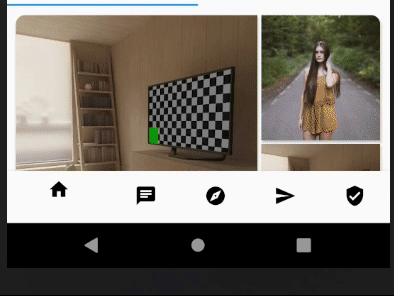由于底部导航栏和标签栏导致底部溢出
@override
Widget build(BuildContext context) {
super.build(context);
SystemChrome.setEnabledSystemUIOverlays(SystemUiOverlay.values);
return AnnotatedRegion<SystemUiOverlayStyle>(
value: SystemUiOverlayStyle(
statusBarColor: Colors.transparent,
),
child: Scaffold(
key: _scaffoldKeyProfilePage,
body: DefaultTabController(
length: 2,
child:RefreshIndicator(
onRefresh: _onRefresh,
child: NestedScrollView(
headerSliverBuilder: (context, _) {
return [
SliverList(
delegate: SliverChildListDelegate(
[ BuildMainProfile(
....//
),
Padding(
...//another design
),
];
},
// You tab view goes here
body: Column(
children: <Widget>[
TabBar(
tabs: [
Tab(text: 'A'),
Tab(text: 'B'),
],
),
Expanded(
child: TabBarView(
children: [
BuildPost(,
),
BuildWings()
],
),
),
],
),
),),
),
以上是我得到的错误示例
错误:RenderFlex 在底部溢出了 48 个像素。
如何解决这个问题?尝试在 TabBar 上使用扩展并将 1 的 flex 赋予标签栏并将 10 的 flex 赋予 tabView ,但该标签栏会在向下滚动时缩小。
下面是 tabBar 视图的代码 A 和 B 甚至相似
class BuildPost extends StatefulWidget {
final String uid;
const BuildPost({
Key key,
@required this.uid,
}) : super(key: key);
@override
_BuildPostState createState() => _BuildPostState();
}
class _BuildPostState extends State<BuildPost> {
List<Post> _post = [];
getUsersPost() async {
final database = FirestoreDatabase();
List<Post> _postModel = await database.getUsersPost(widget.uid);
setState(() {
_post = _postModel.toList();
});
}
@override
void initState() {
getUsersPost();
super.initState();
}
@override
Widget build(BuildContext context) {
return _post.isEmpty
? Container(
height: 500,
width: double.infinity,
)
: GestureDetector(
child: Directionality(
textDirection: TextDirection.ltr,
child: AnimationLimiter(
child: StaggeredGridView.countBuilder(
padding: EdgeInsets.all(10),
shrinkWrap: true,
physics: NeverScrollableScrollPhysics(),
crossAxisCount: 3,
itemCount: _post.length,
itemBuilder: (context, index) {
return AnimationConfiguration.staggeredGrid(
position: index,
duration: const Duration(milliseconds: 500),
columnCount: 3,
child: SlideAnimation(
verticalOffset: 50.0,
child: FadeInAnimation(
duration: Duration(milliseconds: 1000),
child: BuildData(
totalPost: _post.length,
postList: _post,
index: index,
post: _post[index],
)),
),
);
},
staggeredTileBuilder: (index) => StaggeredTile.count(
index % 7 == 0 ? 2 : 1,
index % 7 == 0 ? (2.1) : (1.05)),
mainAxisSpacing: 4.0,
crossAxisSpacing: 4.0,
),
)),
);
}
}
2 个答案:
答案 0 :(得分:1)
这是因为 NestedScrollView 的 body 高度是从 0 到 MediaQuery.of(context).size.height,而你在列内的 TabBar 使它布局的最小高度为标签栏。
在构建器中移动 TabBar
以NestedScrollView为例,可以看到TabBar在headerSliverBuilder里面。您只需将 TabBar 移动到其中(包裹一个 SliverToBoxAdapter 或 SliverAppBar 以使其变细)。
然后您可以删除 TabBarView
上方的Column 和 Expand Widget
child: NestedScrollView(
headerSliverBuilder: (context, _) {
return [
SliverList(
...
),
SliverAppBar(
pinned: true,
primary: false, // no reserve space for status bar
toolbarHeight: 0, // title height = 0
bottom: TabBar(
tabs: [
Tab(text: 'A'),
Tab(text: 'B'),
],
),
)
];
}
body: TabBarView(
children: [
...
答案 1 :(得分:0)
body 的 NestedScrollView 属性得到严格的高度约束,等于 headerSliverBuilder 留下的空间(考虑滚动位置)。在您的代码中,您将一个 Column 小部件作为主体,其中具有固定高度(TabBar)小部件。所以当 body 的高度约束小于 TabBar 高度时,它会溢出 Column。
所以在body中,必须有一个可以缩小到零高度的小部件,很可能是一个可滚动的(ListView,CustomScrollView)。在您的情况下,您可以将 TabBar 移动到 headerSliverBuilder 的底部,将其包装为:
SliverPersistentHeader(
pinned: true,
delegate: SimpleHeaderDelegate(
child: TabBar(...),
),
)
使用:
class SimpleHeaderDelegate extends SliverPersistentHeaderDelegate {
SimpleHeaderDelegate({@required this.child});
final PreferredSizeWidget child;
@override
Widget build(BuildContext context, double shrinkOffset, bool overlapsContent) => child;
@override
double get maxExtent => child.preferredSize.height;
@override
double get minExtent => child.preferredSize.height;
@override
bool shouldRebuild(covariant SimpleHeaderDelegate oldDelegate) => oldDelegate.child != child;
}
相关问题
最新问题
- 我写了这段代码,但我无法理解我的错误
- 我无法从一个代码实例的列表中删除 None 值,但我可以在另一个实例中。为什么它适用于一个细分市场而不适用于另一个细分市场?
- 是否有可能使 loadstring 不可能等于打印?卢阿
- java中的random.expovariate()
- Appscript 通过会议在 Google 日历中发送电子邮件和创建活动
- 为什么我的 Onclick 箭头功能在 React 中不起作用?
- 在此代码中是否有使用“this”的替代方法?
- 在 SQL Server 和 PostgreSQL 上查询,我如何从第一个表获得第二个表的可视化
- 每千个数字得到
- 更新了城市边界 KML 文件的来源?

